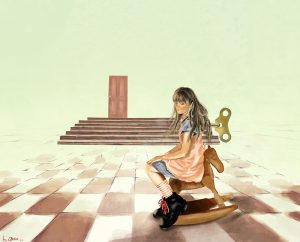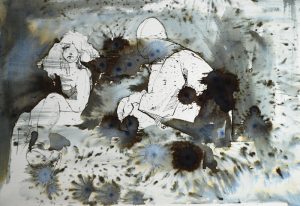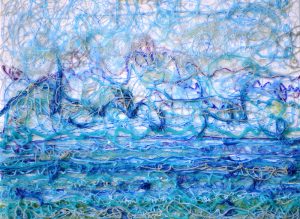An Interview with Featured Artist Carolina Rodriguez

By Cynthia Reeser with Carolina Rodriguez
CR (TROn): Your artwork is wildly imaginative. Where do get your ideas? What inspires you?
Rodriguez: Well, I use everything that surrounds me, the places I go, the people I talk with, the plants, the bugs, the water, the fire, the space, the stars, the galaxies and comets, the constellations, the stories I hear, and sometimes, the feeling of being bored or sad.
CR: Please talk about your development as an artist.
Rodriguez: Everything began around ten years ago when I was fifteen, influenced by movies, comics, and Japanese artists. From there I decided to use digital media as my [primary medium], mainly because I don’t like to clean my brushes. I got into a visual arts career, and since then, I’ve been trying to improve my drawing and learn the programs I use a little better.
CR: All of the work in your online portfolio is digital art. Have you ever tried your hand at any other mediums—painting, drawing, etc.?
Rodriguez: Of course I have. I still draw a lot in a sketch book; I love colored pencils and I try to use them as much as I can. I’m also part of a graphic workshop called “Taller Trez” that involves woodcut and etching techniques.
CR: I notice a lot of texture working in your pieces. For example, in “The Clouds Will Explode,” the background of the wall has a texture similar to that of oil pastels, yet in the window, the images are highly detailed. There is also a transparent quality to some features in the lower third of the image, which contrasts with the objects in the light. Do you consciously create a variety of textures?
Rodriguez: Sometimes I’m just sloppy and mix up things without noticing, but I do like the feeling of messy textures on my paintings. The result is always different, but I really try to apply a lot of things that I learn over the process in previous works. It’s fun every time, but sometimes I get [frustrated when] something is not working. But I understand that even if it doesn’t work, I learned something new.
CR: Many of your pieces are very detailed. Could you talk about your process a bit?
Rodriguez: I’m kind of neurotic; I love detail, even if people can’t see some of the things I include in an image because it’s too small to see. I [need the detail] to be there. My process varies, but I always start with an idea, then form a color palette and create a sketch. Then on the computer I redo the lines, paint underneath them, and from there, it’s chaos—anything can happen. I go crazy and do whatever I feel like. It’s definitely fun.
What’s next for Carolina Rodriguez…
Carolina Rodriguez will be exhibiting her work at the Pontifical Xavierian University at the end of January 2014. For more information on this artist and for news of upcoming exhibitions, go to https://www.facebook.com/TALLER.TREZ
~
Visit Carolina Rodriguez on the web at: http://morbidtea.daportfolio.com/
============================================================================
Carolina Rodriguez is a native of Bogota, Colombia and attends the Pontifical Xavierian University (Pontificia Universidad Javeriana) in Bogota. View her art online at http://morbidtea.daportfolio.com/.
Cynthia Reeser is the Founder and Publisher of Aqueous Books, and Founder and Editor-in-Chief of Prick of the Spindle literary journal. She has published more than 100 reviews in print and online, as well as poetry and fiction in print and online journals. Her short stories are anthologized in the Daughters of Icarus Anthology (Pink Narcissus Press, 2013), and in Follow the Blood: Tales Inspired by The Hardy Boys and Nancy Drew (Sundog Lit, 2013). Cynthia is currently working on a literary short story collection inspired by fairy tale lore. Also a senior editor for two association management companies, she lives and works in the Birmingham area and attends the University of Tampa in pursuit of her MFA in Creative Writing (fiction). Visit her on the web at www.cynthiareeser.com.


















